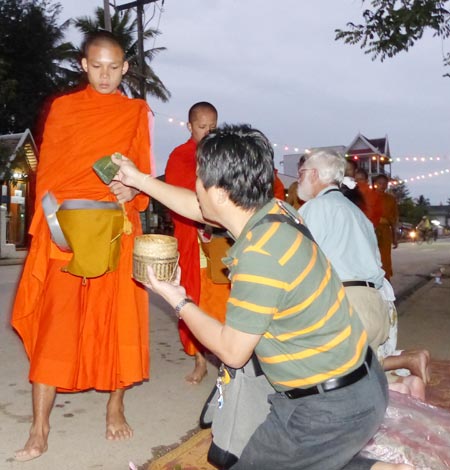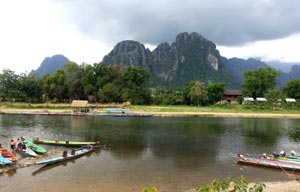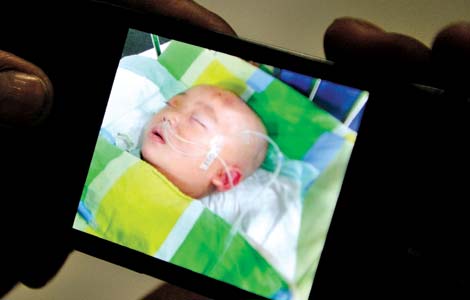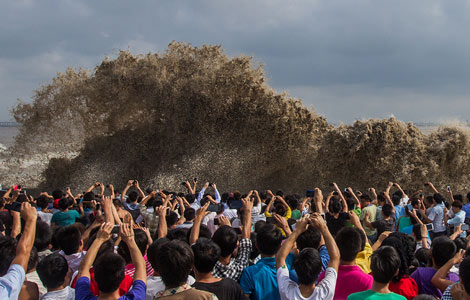City of good karma
Updated: 2013-12-22 13:38
By Wu Liping (China Daily)
|
||||||||
 |
|
Monks receive offerings from devotees at a ceremony at dawn. |
Going forward, we visit an exhibition hall with statues of Buddha collected from museums around the country. Another hall shows off diplomatic gifts from other countries, including silk screens, wood furniture and ivory sculptures from China.
|
 |
In a pavilion, we meet a young monk, Brick.
"I have been a monk for one year, and I plan to stay another year," he says. "I will go to a university for monks after that. I take English and Japanese classes during my spare time and I will learn Mandarin in future since the economy between China and Laos is booming."
The nightlife in the city is best represented by the night market, which operates from dusk until 10 pm, displaying an eclectic collection of handicrafts, souvenirs and traditional clothes.
As one of us tries on a coral bracelet, we find that the stall-owner, Zhu Wenxia, is a Chinese from Hainan province.
"I came to Laos 17 years ago, because I was laid off from work," says Zhu. "I started a business selling small accessories. Now I buy pearls and exotic stones, and string them myself. I make jewelry with an Asian flavor and my customers are mostly Western people.
"They are in the majority among tourists here, especially during the end of the year, which is their vacation season. In recent years, there have been more Chinese tourists, mostly around the Spring Festival. People from Yunnan province often drive here."
Zhu, who lives in the city with her husband, is happy with her life here. "The pace of life is slow, people are simple and food is natural."
Indeed the diet in Laos is simple but healthy.
"We often eat sticky rice for breakfast and lunch, and rice for supper," says Oudomhak, our guide. "Sticky rice is difficult to digest and signals fullness, and is especially good for the poor years. Nowadays, people eat it less because sticky rice contains more sugar than other rice and there is the risk of diabetes."
Anyway I liked the sticky rice, especially the way the locals eat it.
It is soaked in water overnight, and then steamed for 20 minutes. Compared with rice boiled in water, sticky rice is chewy with a smooth texture. Cooked sticky rice is served in small woven bamboo baskets where diners would scoop it up and squash into bite-sized balls.
There is often fried chicken, pork and fish on the dining table, with fresh vegetables to go with it all, including lots of mint leaves and other fresh herbs.
"Restaurants here also feature Chinese, Indian, Thai and Cambodian meals, as well as French and Italian flavors," our guide Oudomhak says, clearly proud of the wide choice of cuisines.
IF YOU GO
Air China/China Eastern Airlines flies from Beijing to Vientiane via Bangkok. Vietnam Airlines operates daily flights from Beijing to Luang Prabang via Hanoi. We took a long-distance bus from Vientiane to Luang Prabang. Lao Airlines flies from Vientiane to Luang Prabang.
In Luang Prabang City, most of the scenic spots are in walking distance from the city center.

 Post-baby Duchess
Post-baby Duchess
 Victoria Beckham S/S 2014 presented during NYFW
Victoria Beckham S/S 2014 presented during NYFW
 'Despicable' minions upset Depp's 'Lone Ranger' at box office
'Despicable' minions upset Depp's 'Lone Ranger' at box office
 'Taken 2' grabs movie box office crown
'Taken 2' grabs movie box office crown
 Rihanna's 'Diamonds' tops UK pop chart
Rihanna's 'Diamonds' tops UK pop chart
 Fans get look at vintage Rolling Stones
Fans get look at vintage Rolling Stones
 Celebrities attend Power of Women event
Celebrities attend Power of Women event
 Ang Lee breaks 'every rule' to make unlikely new Life of Pi film
Ang Lee breaks 'every rule' to make unlikely new Life of Pi film
Most Viewed
Editor's Picks

|

|

|

|

|

|
Today's Top News
Student wounded in school shooting dies
US aircraft hit by gunfire in South Sudan
Memorials mark Lockerbie attack
China's moon rover works stably
H5N2 outbreaks in northern province
Freed Russian oil tycoon lands in Germany
US needs check data gathering
India transfers diplomat to UN
US Weekly

|

|








